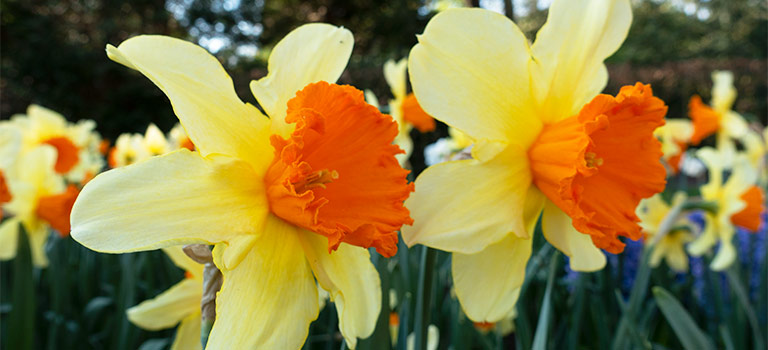One of the most welcome signs of spring is the arrival of the daffodils.
A member of the Amaryllidaceae family, the daffodil (Narcissus) is the easiest and hardiest bulb to grow and is perfect for beginning gardeners. Blooming in the spring, daffodil’s 10,000 cultivars come not only in yellow and white, but also red, orange, and pink. With their bright colors and pleasing shapes, daffodils are great for hillsides, raised beds, planting between shrubs and borders, and in rock gardens.
Daffodil, jonquil, or narcissus?
Narcissus is the Latin name for the family of bulbs commonly called daffodils. The term daffodil comes from “affodill,” borrowed from Latin “affodillus” and “asphodelus” and the Greek “asphodelos,” all of which mean “that which comes early.” The “d” in daffodil probably comes from the French “d” or “de” (meaning “the”). The term was coined in French and English writings of the late 1500s. Although daffodil is an accepted common name for the Narcissus family, some use “daffodil” to refer only to the yellow trumpet-shaped flower and call the rest of the family “narcissus.” In the Southern states, the family is called jonquils, which are actually a variety of narcissus.
The Greek myth of Narcissus
Narcissus was a strikingly handsome young man whose beauty attracted numerous lovers, all of whom found him irresistible and instantly adored him. Narcissus, however, had no interest in romance and mercilessly mocked his admirers. Eventually, a rejected lover begged the gods to punish Narcissus for his arrogance and callousness. Answering the spurned lover’s prayer for vengeance, the goddess Nemesis caused Narcissus to fall in love with his own image in a mountain pool. His feelings consumed him so completely that he never left the pool and eventually wasted away into death. After he died, a daffodil (or narcissus) sprouted in his spot. It is said the flower’s lowered head represents Narcissus’ last pose, staring down into a mountain pool and gazing lovingly at his own reflection.
History
Ancestors of daffodils first sprouted in the Mediterranean region, from Spain and Portugal to Turkey. They grew wild and unnamed until the Greek “Father of Botany,” Theophrastus, named the plant “narcissus” in one of the first botanical registers, Inquiry into Plants. Greeks believed the flower was poisonous, due to the irritation its sap causes on one’s skin, and associated it with death. They also believed the daffodil was a favorite of Hades, the god of the underworld. Later, Roman cultures came to believe the flower possessed healing qualities (although its sap still causes skin irritation).
The Romans took the daffodil to Britain during their pre-Norman occupation of that island. By the 1200s, the flower was a staple of English gardens. The flower’s popularity culminated in a “golden age” that spanned the later part of the 19th century and the early 20th century, during which time breeders created more than 7,000 cultivars. Interest in the bright spring flower leveled out in the years to follow, but it did not disappear entirely. Breeders continued to develop yet more varieties, and today roughly 10,000 daffodil varieties exist.
Did you know?
The first American collection of daffodils was kept by John Bartram, who grew them on his farm along the Schuylkill River in Philadelphia in the 1730s.
Buying bulbs
The perfect bulb is solid and fat, and smells fresh. You’ll find the best selection if you shop as early in the season as you can. Daffodils are generally planted in the fall before the ground freezes, but many catalog companies will let you order in the spring (when you see a new variety you particularly like, perhaps) for fall delivery. Until you’re ready to plant your bulbs, store them in a cool, dark, dry place. If you let them get too warm, bulbs will sprout prematurely.
Daffodil Decoy Deep red cup surrounded by snow-white petals Type: Trumpet (Division I) Height: 12-14” Early to mid spring.
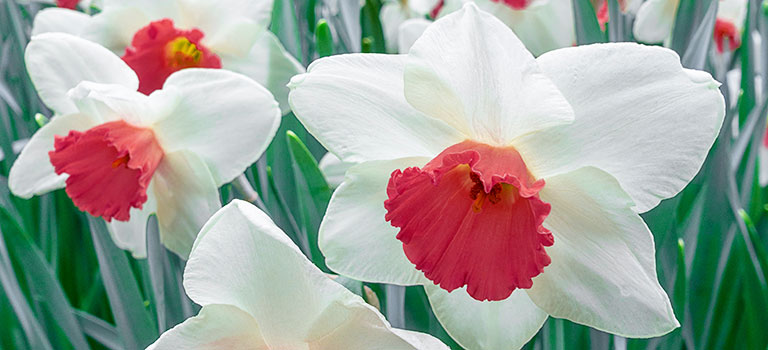
Breck’s Colossal Daffodil Giant yellow daffodil Type: Trumpet (Division I) Height: 18-20” Early to mid spring.
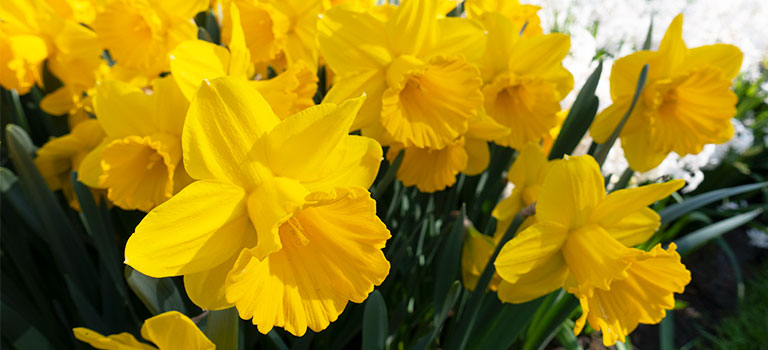
Colin’s Joy Daffodil White petals surrounding an orange-yellow cup Type: Small-Cupped (Division III) Height: 14-18” Mid spring.
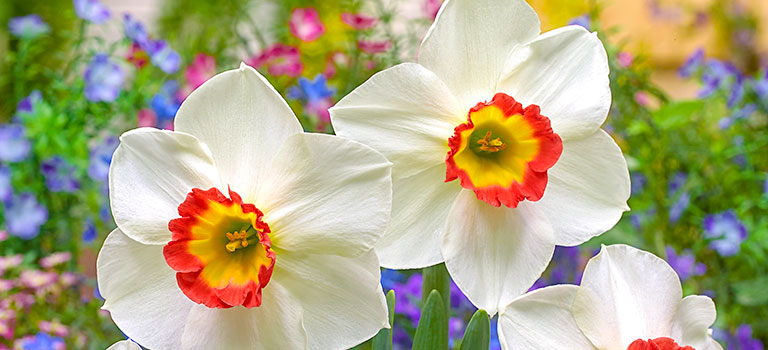
Replete Daffodil Rose pink and ivory white Type: Double (Division IV) Height: 18-20” Early to mid spring.

Original Poet’s Daffodil White petals and small yellow cup with orange edge and green center Type: Poeticus (Division IX) Height: 13-15” Late spring.

Tahiti Daffodil Orange-red centers. : Split-Corona (Division XI) Height: 18-20” Early to mid spring.
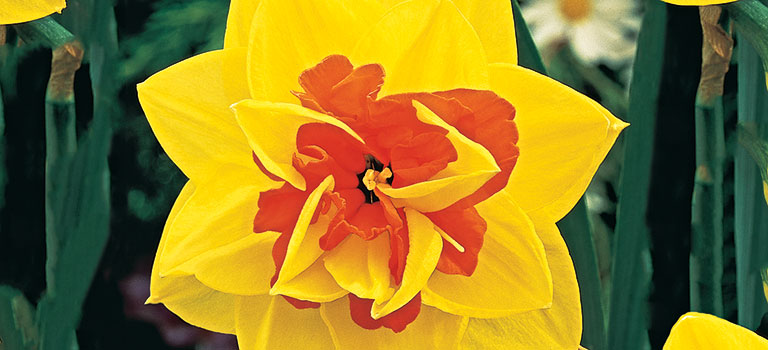
Apricot Whirl Daffodil White frothed, apricot-pink cup with ivory-white petals Type: Split-Corona (Division XI) Height: 16-18” Lightly fragrant 4” blooms Mid spring.

Tête-à-Tête Daffodil Golden-yellow flower with a long trumpet and strongly swept back petals. Type: Other (Division XII) Height: 6-8” Early spring.
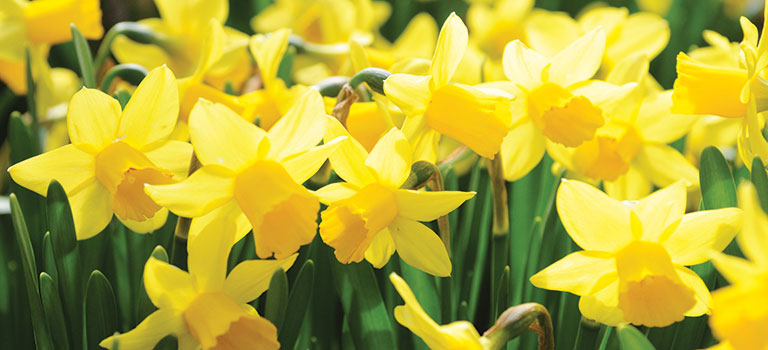
Planting bulbs
Daffodils prefer sunny and partially shady areas that get at least half a day of sun. You can plant bulbs just about everywhere except beneath evergreen trees; you can, however, plant them under deciduous trees, which won’t leaf out until after the daffodils have bloomed. They like moist, slightly acidic (pH 6.75), well-drained soil. The perfect planting depth is about three times as deep as the bulb is tall; in general, you’ll plant bulbs 7-8” deep and 4-6” apart.
If you’re planting just a few bulbs, the easiest way is to dig a series of holes, each large enough to accommodate four or five bulbs. If you’re planting a lot of bulbs, you can either dig a trench (for a nice long swath of blooms), or get a special gardening awl attachment for your power drill to dig each hole individually. Sprinkle some bone meal in the holes to give the bulbs a head start.
If your soil is bad, dig a bed to a depth of 18”. Add about 6” of well-rotted manure, into which you should mix topsoil such that the hole is filled about two-thirds of the way. Set the bulbs on top of the compost-soil mixture, and cover them with additional topsoil to ground level. For a prolonged blooming season, you can plant bulbs at different depths in this bed. If drainage is a problem, plant your bulbs on a hillside or in raised beds.
After planting, water the area generously. Bulbs are typically pest-free, but sometimes fall victim to the narcissus bulb fly, eel worms, and fungal infections. Flushing infected bulbs with hot water or using fungicides before you plant can help.
A pot of gold
If you’d rather use pots, plant your bulbs in October. Start with a 16-24” pot and fill it with soil to about 5” from the rim (adding bone meal or fertilizer, if you’d like.) Place the bulbs on this soil, making sure they don’t touch, cover them with more soil, and mulch. Water well for the first few weeks, then water only as necessary until spring. When the first leaves emerge, move your pots to a sunny location, top-dress with a low-nitrogen fertilizer mix, and water regularly.
To tie back, or not to tie back
After your daffodils are done blooming, their foliage will remain for several weeks. Tying back or braiding the foliage is a common practice, but not advisable, since the leaves are using the sun’s rays to create food that will be used for next year’s flowers. By tying them back, you’re depriving the plant of some food-making potential. Instead, top-dress the area with compost or fertilizer and remove the leaves only after they turn yellow or brown. To hide the unsightly foliage, plant summer-blooming perennials (like daylilies) or tall annuals in the same bed.
Bulb division
Typically, daffodils are divided every three to five years, or when the quality and quantity of blooms have deteriorated. The best time to divide is about eight weeks after flowering (usually June or July, or when the leaves die back). Choose an overcast day to avoid sun damage. Before starting the division process, dig a hole that is three times as large as the clump’s previous home. To divide, simply separate each clump into sections, making sure to avoid tearing the roots. After planting, water and don’t fertilize until the following year.
Naturalizing
Although daffodils have a solid place in history as a formal garden flower, recent trends are more casual. Instead of planting bulbs in straight lines, naturalize the display by planting numerous bulbs in an open area and letting them multiply on their own. For a truly informal look, gently toss the bulbs onto the area where you want to plant and then dig a hole for each bulb where it lands.
Fortissimo Daffodil These ‘Fortissimo’ daffodils grow 18-20” high and bloom early to mid spring. Even in smaller plantings than this, they make a dramatic display. 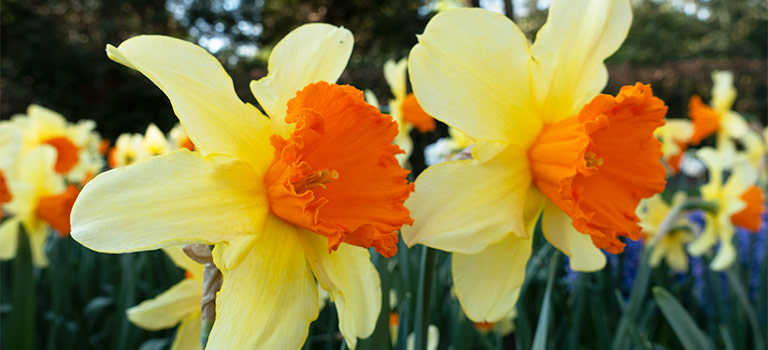
Narcissus Divisions
Horticulturalists have categorized 12 different divisions of narcissus, all of which except Division X (wild species) are hybridized to one degree or another.

Division I
Trumpet: One flower to a stem, cup as long as or longer than the petals; 10-18” tall.
Division II
Large-Cupped: One flower to a stem with a trumpet-shaped cup that is longer than one third of, but not as long as, the petals.
Division III
Small-Cupped: One flower to a stem and the cup is less than one-third of the length of the petals.
Division IV
Double: Can be one or more flowers per stem with more than one ring of petals, or cup.
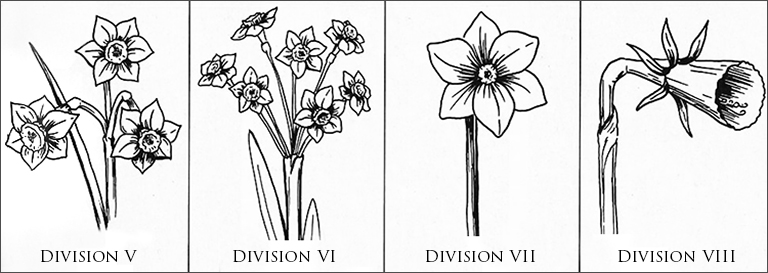
Division V
Triandrus: Usually more than one flower to a stem, head drooping, and with swept back silky petals.
Division VI
Cyclamineus: Single flower with swept back petals on each stem, and a wavy narrow-rimmed cup.
Division VII
Jonquilla: One to five, fragrant flowers on round, hollow stems; 1’ tall.
Division VIII
Tazetta: Up to 20 very short cupped flowers on each stem or large-flowered forms with three or four flowers on each stem; fragrant.
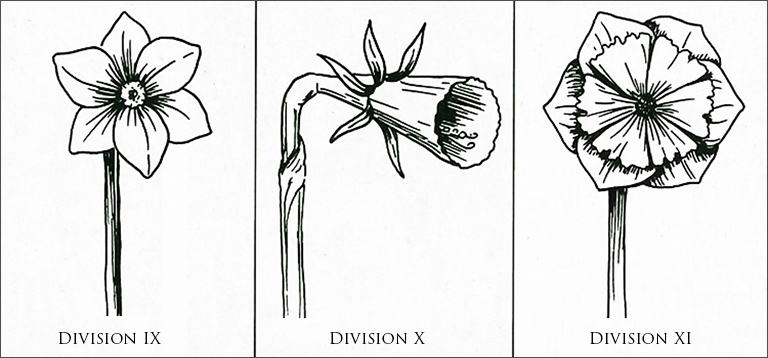
Division IX
Poeticus: One flower with flat, shallow cups and white petals sometimes stained with the cup color at the base.
Division X
Wild species, including the Bulbocodium shown as a typical example (small flowers; hoop-petticoat trumpet).
Division XI
Split-Corona: Usually one flower to a stem; corona split for at least one-third of its length.
Division XII
“other cultivars,” is so truly miscellaneous that there is no typical example to use as an illustration.

